Age-Related Hair Loss Pattern Checker
Hair Loss Pattern Assessment
Answer the following questions to determine if your hair loss pattern aligns more with androgenic alopecia or general age-related thinning.
Your assessment will appear here after answering the questions and clicking "Assess My Pattern".
Ever wondered why your hairline keeps receding as you get older? The answer isn’t just about genetics; the natural ageing process plays a big role in the way androgenic alopecia shows up and progresses. Below we break down the biology, the clues that separate age‑related thinning from classic male pattern baldness, and the practical steps you can take to keep your scalp looking its best.
What Is Androgenic Alopecia?
Androgenic alopecia is a chronic hair‑loss condition that follows a predictable pattern-typically a receding hairline and thinning at the crown. It accounts for about 95% of all male hair loss and is driven by genetics and androgens, especially dihydrotestosterone (DHT). The condition is also called male pattern baldness. This form of alopecia is not a disease in the traditional sense; it’s a lifelong shift in the way hair follicles behave.
How Aging Changes the Hair Environment
When you age, several physiological changes create a harsher environment for hair follicles. Collagen in the dermis gradually breaks down, reducing the structural support around each follicle. This loss of scaffolding weakens the anchoring of follicles, making them more susceptible to mini‑miniaturization- the process where thick terminal hairs shrink into fine vellus hairs.
In addition, the scalp’s microcirculation slows down. Reduced blood flow means fewer nutrients and oxygen reach the hair matrix, impairing the growth phase (anagen). Oxidative stress accumulates as free radicals damage cellular DNA, including the cells that regulate the hair cycle.
Hormonal Shifts: Testosterone, DHT, and Enzymes
Dihydrotestosterone (DHT) is the potent androgen responsible for shrinking hair follicles. DHT forms when the enzyme 5‑alpha‑reductase converts testosterone. As men age, testosterone levels slowly decline, but the activity of 5‑alpha‑reductase often remains stable or even rises in the scalp. This creates a paradox: lower systemic testosterone but relatively higher local DHT.
The increased DHT binds to androgen receptors in the follicle’s dermal papilla. Over time, this binding triggers a cascade that shortens the anagen phase and extends the telogen (resting) phase, resulting in thinner, shorter hairs.
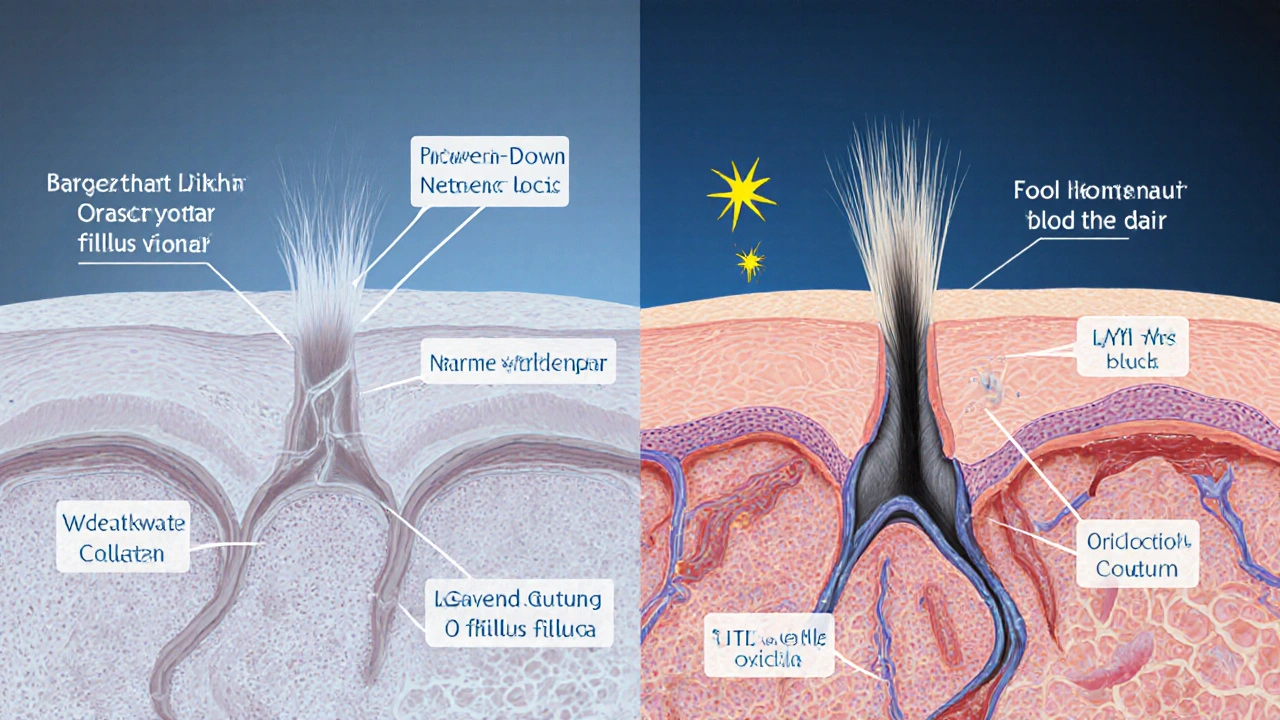
Follicle Miniaturization Over Time
The hallmark of androgenic alopecia is follicle miniaturization. With each growth cycle, affected follicles produce hairs that are 20‑30% thinner than before. Aging accelerates this process because the regenerative capacity of stem cells in the bulge region diminishes. Studies on scalp biopsies from men over 50 show a 40% increase in miniaturized follicles compared to biopsies taken from men in their 30s.
Beyond size, the pigment-producing melanocytes also fade, leading to the “white‑gray” hair band that often appears before noticeable thinning. This visual cue is a useful early warning sign that age‑related hormonal shifts are already at work.
Distinguishing AGA from General Age‑Related Thinning
Not all thinning hair is androgenic. Age‑related diffuse thinning usually presents as a uniform reduction in density across the scalp, without the classic Norwood pattern (receding temples and vertex balding). Here are three practical ways to tell them apart:
- Pattern: AGA follows a predictable V‑shaped recession; diffuse thinning is even.
- Hair shaft diameter: In AGA, the ratio of thick to thin hairs shifts dramatically; pure age‑related thinning maintains a relatively even diameter distribution.
- Speed of change: AGA can progress 0.5cm per year in the frontal region; diffuse thinning typically occurs at a slower, steadier pace.
Knowing the difference matters because treatment options vary. For example, finasteride targets DHT production-a key driver in AGA but less effective for non‑androgenic thinning.
Management Strategies for Aging Men
When age and AGA intersect, a multi‑pronged approach often yields the best results. Below is a concise checklist of evidence‑based options:
- Finasteride (a 5‑alpha‑reductase inhibitor) reduces scalp DHT by up to 70% and can halt or reverse miniaturization in about 65% of users.
- Minoxidil (a vasodilator) improves microcirculation, extending the anagen phase and adding 10-25% more hair density when applied twice daily.
- Low‑level laser therapy (LLLT) stimulates mitochondrial activity in follicular cells, showing a modest 12% increase in thickness after six months.
- Platelet‑rich plasma (PRP) injections deliver growth factors that may rejuvenate dormant follicles, especially in men over 45.
- Scalp microneedling (0.5mm) enhances drug absorption and triggers wound‑healing pathways that support new hair growth.
It’s wise to combine systemic (finasteride) and topical (minoxidil or LLLT) treatments for synergistic benefits. Always consult a dermatologist before starting prescription therapy, especially if you have prostate concerns or are taking other medications.
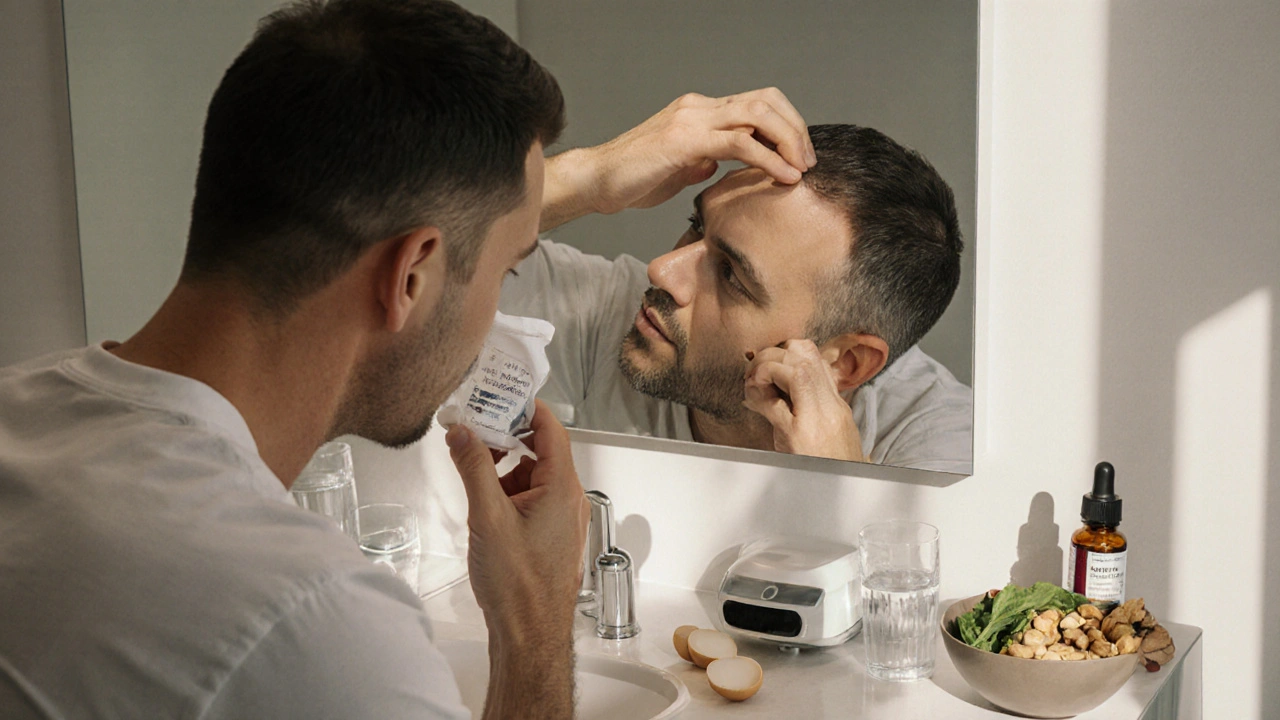
Lifestyle & Prevention Tips
While medicines can slow the process, everyday habits also influence how quickly AGA progresses with age:
- Nutrition: Adequate protein (1.2g/kg body weight) and micronutrients like zinc, biotin, and vitaminD support keratin production.
- Stress management: Chronic cortisol spikes can push follicles into telogen, worsening thinning. Practices like meditation or moderate exercise reduce this risk.
- Hair care: Gentle shampooing, avoiding tight hairstyles, and limiting heat styling reduce mechanical trauma that can exacerbate miniaturization.
- Sleep: 7-8hours per night promotes growth‑hormone release, which aids follicle regeneration.
- Avoid smoking: Tobacco constricts scalp vessels, further limiting nutrient delivery.
Integrating these habits doesn’t replace medical treatment, but it can lengthen the window before hair loss becomes noticeable.
Quick Comparison: AGA vs. General Age‑Related Thinning
| Feature | Androgenic Alopecia (AGA) | General Age‑Related Thinning |
|---|---|---|
| Pattern | Receding temples, vertex balding (Norwood scale) | Uniform density loss across scalp |
| Primary Driver | DHT binding to follicular androgen receptors | Reduced blood flow, collagen loss, hormonal decline |
| Hair Shaft Diameter | Marked shift to fine vellus hairs | Gradual, proportional thinning |
| Effective Medications | Finasteride, Minoxidil, LLLT | Topical minoxidil, nutritional support |
| Onset Age | Late teens to early 30s (accelerates after 40) | Typically after 50years |
Next Steps & Troubleshooting
If you suspect your hair loss is tied to aging, start with a simple self‑assessment: take a close‑up photo of your scalp, note the pattern, and compare your hair shaft thickness using a magnifying lens. A dermatologist can confirm AGA with a scalp biopsy or trichoscopy.
Common roadblocks and fixes:
- Unsatisfactory response to finasteride after 6 months: Add minoxidil or consider low‑level laser therapy.
- Scalp irritation from topical treatments: Switch to a foam formulation or reduce application frequency.
- Plateau after 12 months: Incorporate PRP or microneedling to reactivate dormant follicles.
Remember, hair growth is a slow process. Patience and consistency are as important as the right products.
Frequently Asked Questions
Does aging make DHT levels higher?
Systemic testosterone drops with age, but the enzyme 5‑alpha‑reductase often stays active in the scalp, so local DHT can remain high or even increase relative to available testosterone.
Can I prevent androgenic alopecia entirely?
Because genetics plays a strong role, complete prevention isn’t realistic. However, early intervention with DHT blockers and healthy scalp habits can delay onset and reduce severity.
Is finasteride safe for men over 50?
Finasteride is FDA‑approved for men 18 and older. Studies show it remains effective after 50, but users should discuss prostate health and potential sexual side effects with their doctor.
What lifestyle changes matter most for aging hair?
Prioritize a balanced diet rich in protein and micronutrients, manage stress, quit smoking, and maintain regular scalp hygiene. These steps support overall follicle health and can slow thinning.
How long does it take to see results from minoxidil?
Most users notice visible improvements after 3-6months of twice‑daily application. Full benefits may take up to a year.
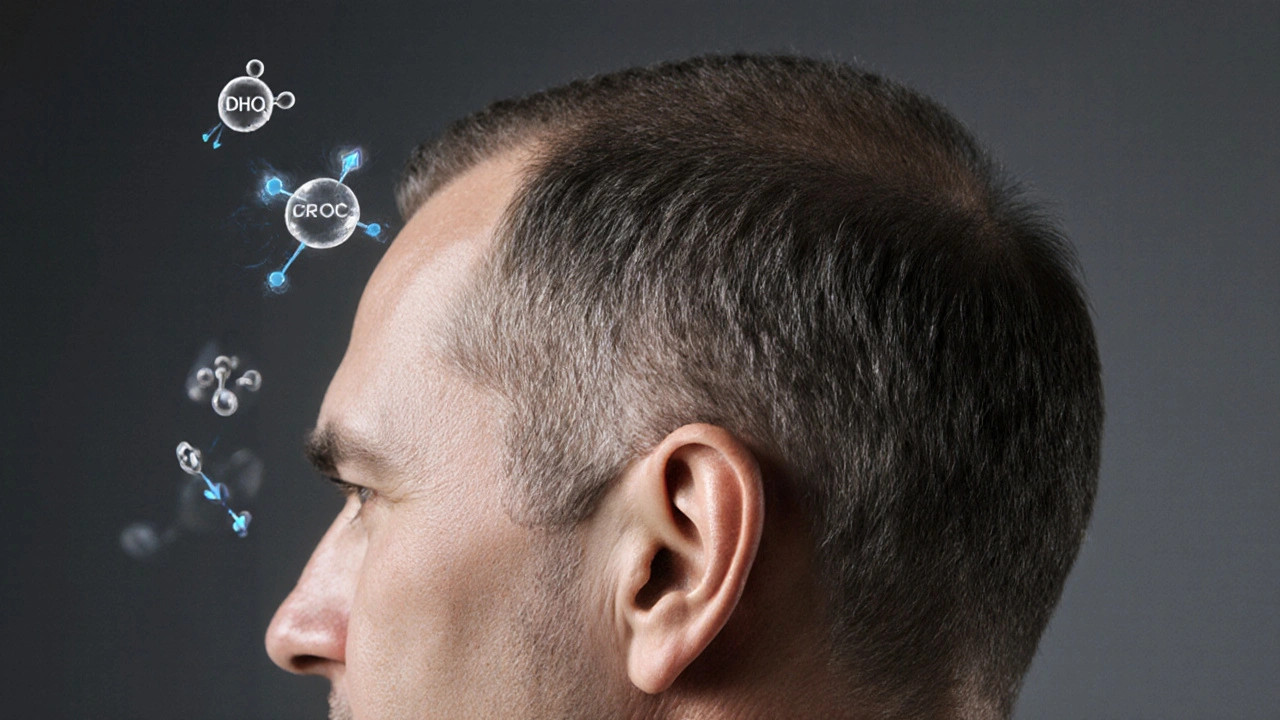



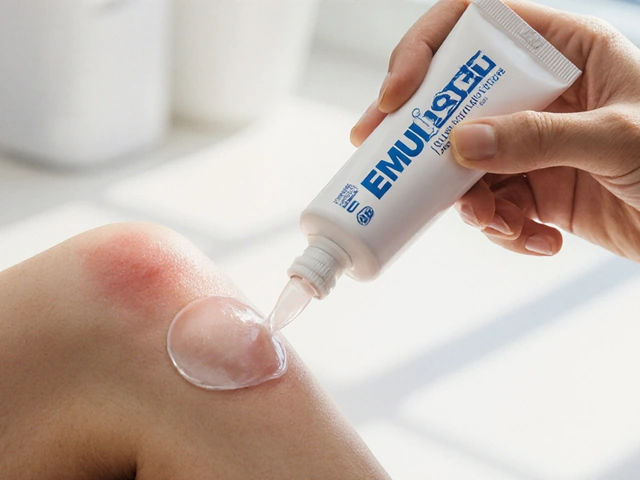
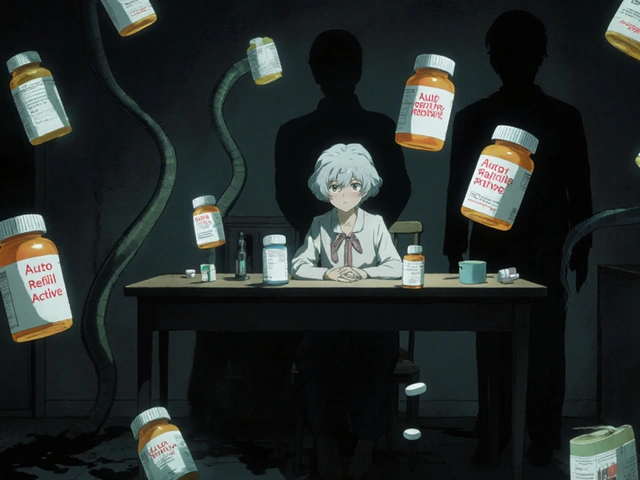
12 Comments
Alisa Hayes
October 7, 2025 AT 15:06 PMI appreciate the thorough breakdown of how aging interacts with androgenic alopecia, especially the emphasis on collagen loss and microcirculation decline.
Mariana L Figueroa
October 8, 2025 AT 08:06 AMGreat summary! If you start finasteride early and combine it with a healthy diet, you can really slow down the miniaturization process.
Lily Tung
October 9, 2025 AT 11:53 AMOne must first acknowledge that the pathophysiology of androgenic alopecia is not a mere triviality but a complex convergence of endocrine, dermal, and vascular factors; the decline of dermal collagen constitutes a structural deficit that predisposes follicles to heightened DHT susceptibility; concurrently, the attenuated scalp perfusion curtails the delivery of essential nutrients, thereby exacerbating the hair cycle's anagen shortening; oxidative stress, an oft‑overlooked parameter, accrues with advancing age, inflicting DNA damage upon follicular stem cells and impairing regeneration; the paradoxical constancy or elevation of 5‑alpha‑reductase activity in the scalp despite systemic testosterone decline underscores a localized hormonal milieu that favors DHT‑driven miniaturization; each successive hair cycle yields follicles producing hairs of diminishing caliber, a quantifiable reduction that can approach a 30‑40% decrease in shaft diameter over years; this miniaturization is further compounded by the attrition of melanocyte activity, manifesting as premature graying that often precedes visible thinning; clinical differentiation between AGA and diffuse age‑related thinning hinges upon the topographic pattern, hair shaft diameter distribution, and the velocity of change, each of which informs therapeutic stratagems; pharmacologic intervention with finasteride effectively curtails DHT synthesis, yet its efficacy is contingent upon adherence and monitoring for potential systemic effects; topical minoxidil augments microcirculatory flow, thereby extending anagen phase and modestly increasing hair density; adjunctive modalities such as low‑level laser therapy and platelet‑rich plasma aim to revitalize follicular metabolism, albeit with variable evidence bases; the integration of lifestyle modifications-adequate protein intake, micronutrient optimization, stress mitigation, cessation of smoking, and sufficient sleep-serves to scaffold the pharmacologic regimen; patient education regarding realistic timelines is paramount, as observable benefits from minoxidil typically emerge after three to six months, while finasteride may require a longer horizon for maximal effect; moreover, clinicians should remain vigilant for signs of treatment plateau, at which juncture combination therapy or procedural interventions like microneedling may be warranted; ultimately, a personalized, multimodal approach, grounded in an understanding of the underlying biological processes, offers the best prospect for attenuating hair loss progression in the aging male population.
Myra Aguirre
October 10, 2025 AT 15:40 PMConsistent scalp hygiene can make a noticeable difference.
Carl Mitchel
October 11, 2025 AT 19:26 PMLet’s be clear: the moral responsibility of any dermatologist is to present these treatments as options, not mandates, because the societal pressure to conform to a youthful bald‑free image is ethically dubious.
Josh SEBRING
October 12, 2025 AT 23:13 PMBut honestly, the whole “you must take finasteride” narrative is just another way pharma keeps us hooked; many guys never need a pill if they just keep the scalp cool and avoid stress.
Suzette Muller
October 14, 2025 AT 03:00 AMI’ve seen patients who feel overwhelmed by the sheer amount of information, so I always suggest starting with a simple nutrient‑rich diet and a gentle shampoo before adding prescription meds.
Ujjwal prakash
October 15, 2025 AT 06:46 AMHonestly, the whole notion that aging hair is just “wear and tear” is too simplistic; the endocrine shifts, especially the local DHT dynamics, are a major driver and cannot be ignored! Also, many people underestimate how lifestyle plays into the whole process, which is why I always stress a holistic approach.
Shawn Towner
October 16, 2025 AT 10:33 AMWhile I respect the clinical data, I’d argue that many of these “evidence‑based” treatments are over‑hyped and that natural resilience of hair follicles, when nurtured correctly, can be enough to keep thinning at bay without pharmaceutical intervention.
Diane Helene Lalande
October 17, 2025 AT 14:20 PMIt’s helpful to remember that everyone’s hair journey is unique; encouraging patients to track progress with photos can provide motivation and a realistic sense of timeline.
Taryn Bader
October 18, 2025 AT 18:06 PMHonestly, I think the drama around hair loss is blown out of proportion; just keep it simple, eat well, and don’t obsess over every little change.
mausumi priyadarshini
October 19, 2025 AT 21:53 PMInterestingly, despite the plethora of studies, one could argue that the emphasis on DHT as the sole culprit oversimplifies a multifactorial condition; perhaps more research should focus on micro‑circulatory health and oxidative stress mitigation rather than just hormonal blockade.